Think of Horseshoe Bend as a well-kept secret that’s only semi-secret. You’ll catch vivid sunrises, wander sculpted sandstone, and slide into cool canyon shadows with a guide who knows the turns. You can boat or kayak Lake Powell, spot bighorn at dawn, shop authentic Navajo silver, or simply sit where the cliffs meet the water and plan your next move. Keep going — there’s more to map out.
Sunrise at Horseshoe Bend
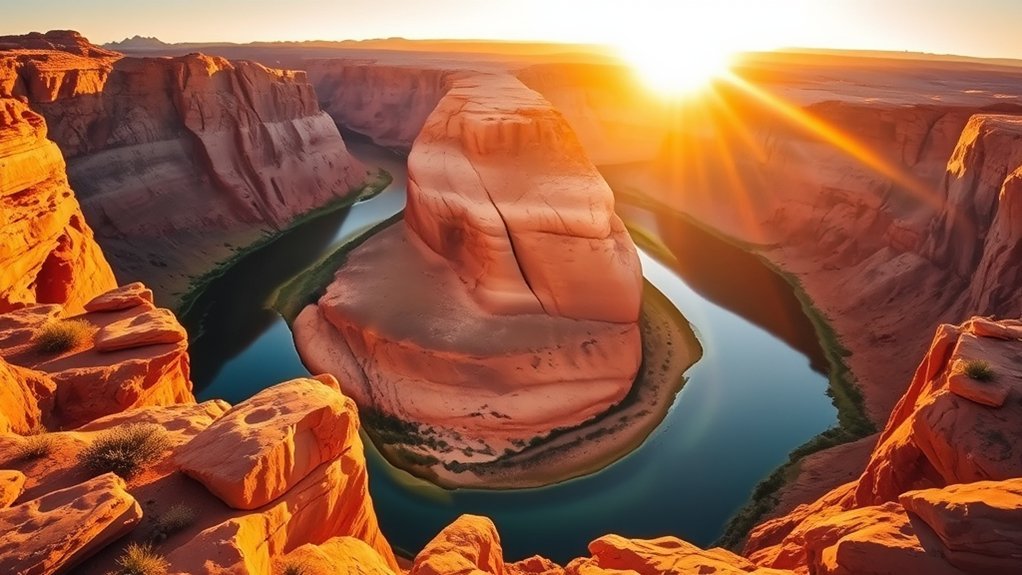
If you get to Horseshoe Bend before dawn, you’ll watch the canyon wake up as soft pink light spills across the Colorado River and the sandstone walls glow. You’ll hike the short, sandy trail in cool air, keeping a steady pace so you’re at the rim when colors deepen. Bring a headlamp for the return, sturdy shoes for uneven ground, and a windbreaker—the rim gets gusty. Choose a spot along the railing, set your tripod low for stable shots, and frame the bend to include the river’s curve and layered cliffs. Watch how shadows retreat, revealing texture and contrast; take a few quiet minutes to listen to the vastness. Expect other photographers, but you can find a quieter niche by arriving early or moving a bit along the overlook. After sunrise, stroll the viewpoints, hydrate, and plan your next stop while the morning light softens and the day warms.
Guided Tour of Antelope Canyon
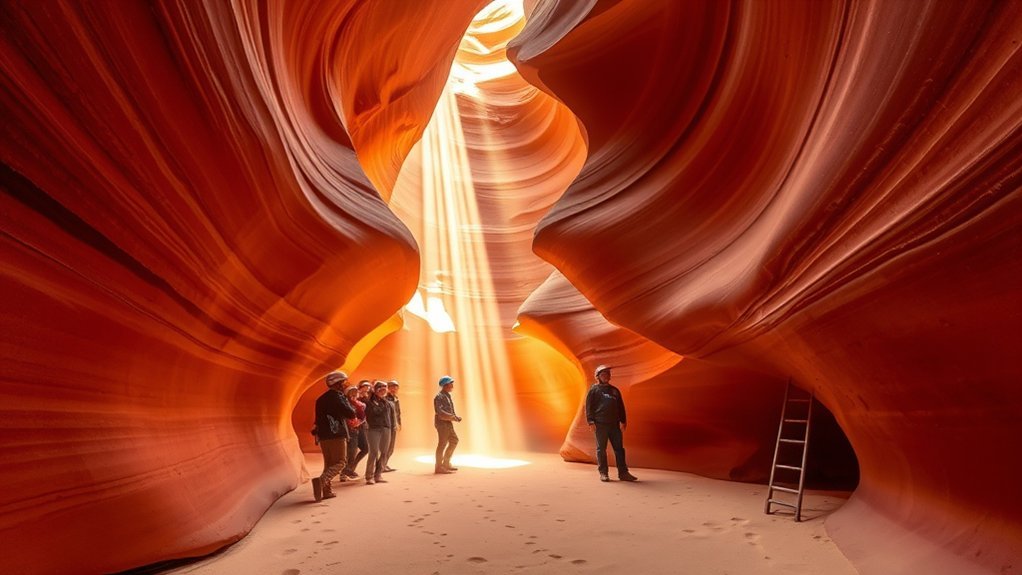
After watching sunrise spill color across Horseshoe Bend, head over to nearby Antelope Canyon with a booked guided tour—it’s the only way in and the best way to understand the slot’s light and geology. You’ll follow a local guide who times visits for ideal shafts of light that paint the sandstone in oranges, pinks, and deep purples. Walk slowly; the corridor narrows and widens, revealing sculpted walls carved by flash floods over millennia. Your guide will point out rock features, explain Navajo cultural significance, and advise on photography angles so you get crisp shots without trampling others’ views. Wear stable shoes and bring a lightweight camera or phone—tripods are often restricted. Expect mild stair and sand passages; if you’re claustrophobic, pick an open section tour. Tours sell out, so reserve in advance and arrive early for check-in. You’ll leave with vivid images and a clearer sense of how water and time sculpt desert stone.
Boat Cruise on Lake Powell
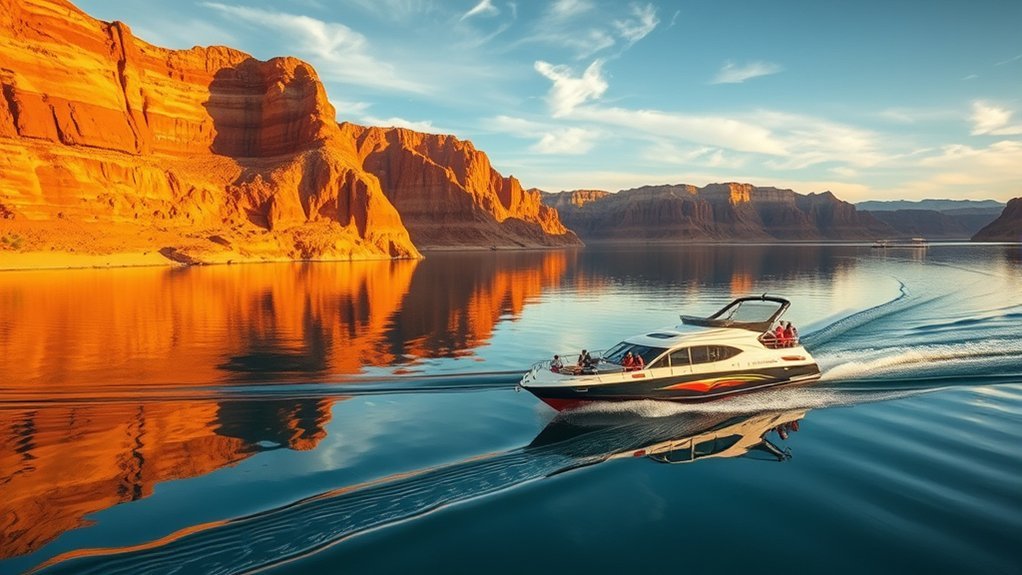
Cruising Lake Powell puts you inside a postcard of sheer sandstone cliffs, hidden beaches, and turquoise water—so pick a morning or late-afternoon departure for softer light and cooler temperatures. On a guided boat tour you’ll glide through narrow canyons, pass dramatic buttes, and learn about Glen Canyon’s geology and history from a knowledgeable captain. Bring a hat, layered clothing, sunscreen, and a refillable water bottle; temperatures shift quickly on open water. Cameras do well here—use a polarizing filter to cut glare and capture the saturated colors. Many cruises stop for short shore excursions, giving you time to explore slot canyons or relax on quiet sandbars. Choose a tour length that matches your energy: two- to three-hour scenic trips suit most visitors, while full-day options include longer hikes and swimming. Book in advance during peak season, arrive early to board smoothly, and listen to safety briefings so you can enjoy the views worry-free.
Kayaking Glen Canyon
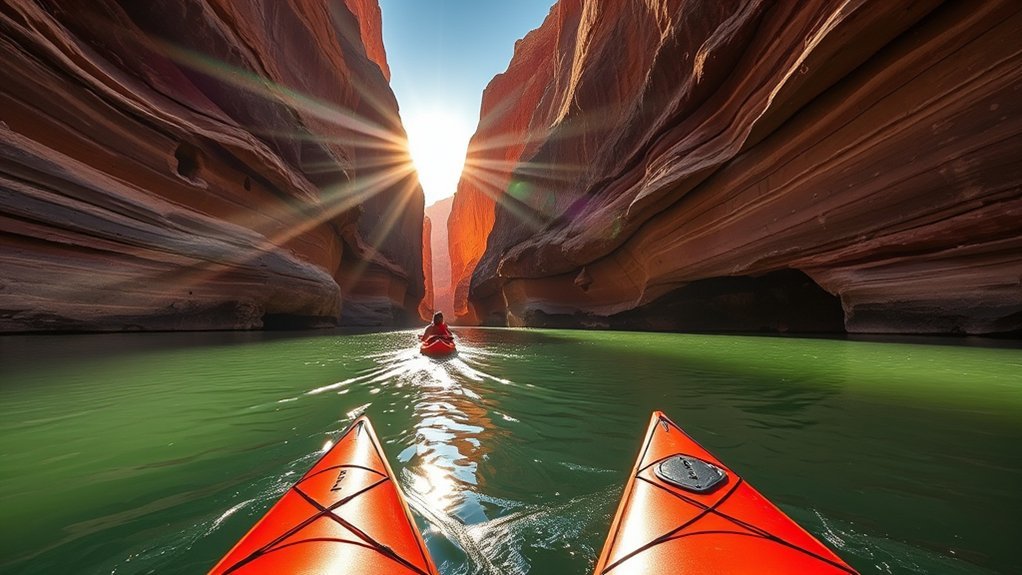
Paddling Glen Canyon puts you face-to-face with towering red walls, narrow slot canyons, and quiet coves that you can only access by water; expect a mix of calm flat stretches and occasional wind-driven chop that keeps the trip engaging. You’ll launch from a marina or shuttle to a quieter inlet, then steer toward arches, hidden beaches, and carved sandstone alcoves. Bring a lightweight, stable kayak, layered clothing, sunscreen, and plenty of water — temperatures swing quickly against the rock. Watch for sudden gusts and learn basic strokes and bracing; currents are usually mild but wind can surprise you. Plan trips around morning or late afternoon winds, and carry a dry bag with snacks, phone, and a map or GPS. If you want a guide, local outfitters provide gear, instruction, and route ideas for different skill levels. Glide slowly to spot desert bighorn, nesting swallows, and delicate geological details you’d miss from a powerboat.
Hike to Rainbow Bridge National Monument
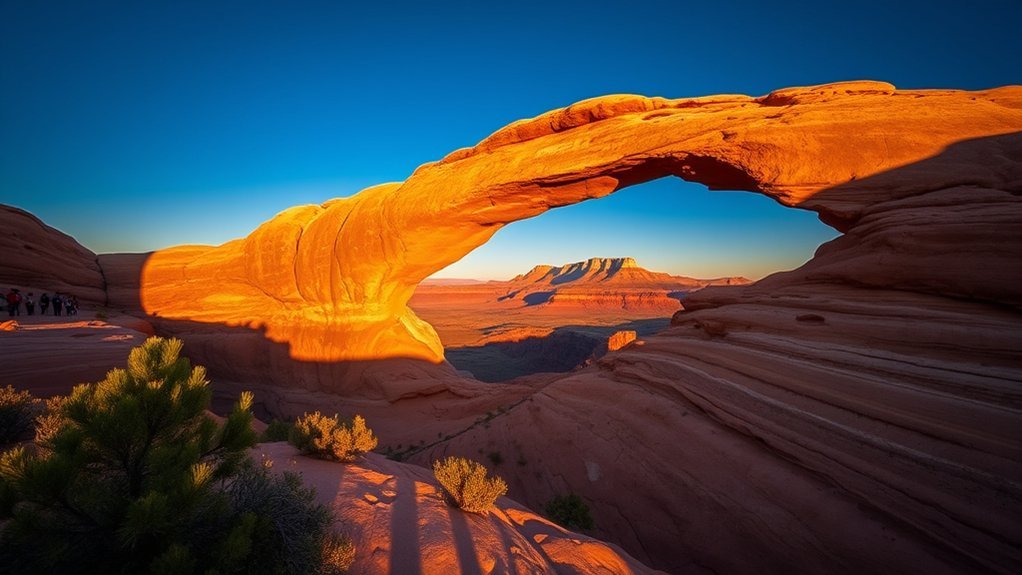
If you want a dramatic, up-close encounter with one of the world’s largest natural bridges, lace up your boots and head to the trail that winds through sun-baked desert and shaded riparian stretches toward Rainbow Bridge National Monument. You’ll follow a clear path with sandstone steps, occasional slickrock crossings, and shady cottonwood groves that offer cool relief. Bring water, sun protection, and sturdy shoes; temperatures climb fast and shade can be scarce. The approach rewards you with changing perspectives: distant cliffs, a sudden pool, then the bridge towering above its canyon like a carved gateway. Photography’s best in early morning or late afternoon when light sculpts the arch’s textures. Respect the site—stay on trails, avoid climbing the arch, and pack out any trash. If you’re visiting by boat, coordinate drop-off times and permits in advance. Finish your hike slowly, soaking in the view and the quiet; this place feels timeless, and the silence is part of the wonder.
Explore the Vermilion Cliffs National Monument
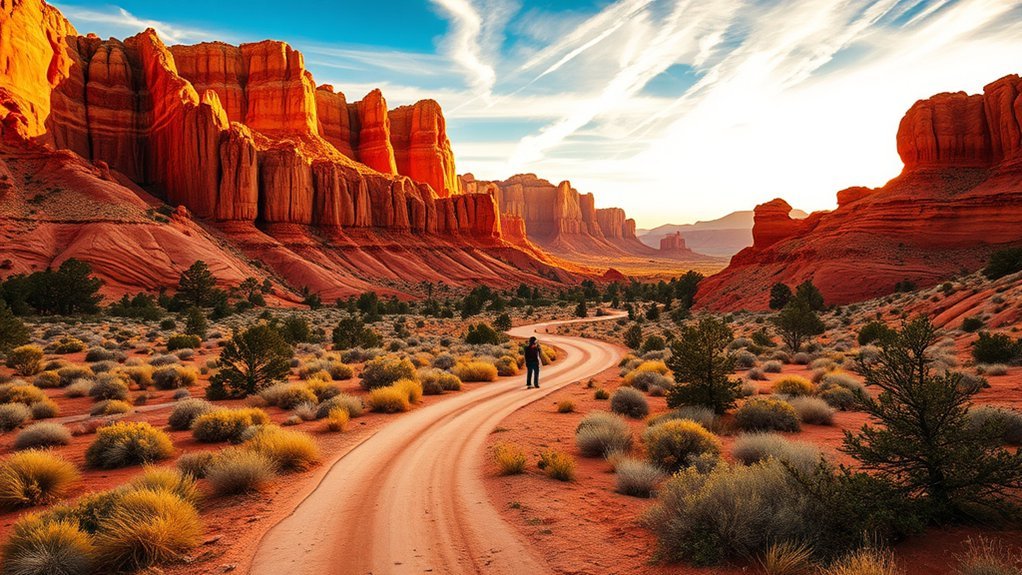
Head to Vermilion Cliffs National Monument and you’ll find prime wildlife viewing spots where bighorn sheep and raptors often appear against dramatic red rock backdrops. Take the scenic drives and overlooks for effortless panoramas, then park and stretch your legs on remote hiking trails that reward you with solitude and unique geology. Bring water, a map, and patience—cell service is spotty and conditions can change quickly.
Wildlife Viewing Spots
Often you’ll spot raptors cruising the thermals above the rust-red cliffs, but the Vermilion Cliffs National Monument offers much more than spectacular views—it’s a living habitat where bighorn sheep, mule deer, coyotes, and rare California condors move through rugged canyons and plateaus. You’ll want binoculars, quiet shoes, and patience. Walk dawn trails, scan ledges and washes, and listen for rustles; animals blend into the desert palette. Respect closures and nesting areas to protect species. Best times are early morning and late afternoon; midday heat sends wildlife to shade. Use cameras with zoom lenses and keep distance. Below is a quick checklist to plan your outing:
| Time | Gear | Target species |
|---|---|---|
| Dawn | Binoculars | Bighorn sheep |
| Dusk | Camera | Condors |
| Midday | Water | Coyotes |
Scenic Drives & Overlooks
While the roads through Vermilion Cliffs can feel remote, they reward you with sweeping overlooks, narrow canyons, and dramatic color shifts that change by the hour; bring a full tank, sunscreen, and patience for pullouts. You’ll drive slow, stop often, and watch light sculpt sandstone cliffs. Pull over where signs and discreet turnouts allow; roads can be rough, so a high-clearance vehicle helps. Binoculars reveal condors and bighorn sheep on distant ledges. Sunrise and late afternoon deliver the richest hues; mid-day is best for clear views and navigation. Leave no trace: pack out trash and stay on designated overlooks to protect fragile surfaces.
- Sunlit ridgelines glowing orange against a blue sky
- Narrow slot-like cuts framing distant plateaus
- Wind-polished rock with thin desert varnish
- Sparse junipers clinging to sheer drop-offs
- Long shadows stretching across rippled sandstone
Hiking Remote Trails
After soaking in the overlooks, you’ll want to set out on foot to really feel the scale of Vermilion Cliffs National Monument — remote trails wind from wide mesas into tight canyons where silence and geology take center stage. You’ll follow faint boot paths and cairns across slickrock, switchbacks and wash bottoms, so bring sturdy shoes, sun protection and plenty of water. Plan for navigation challenges: carry a map, compass or GPS and know how to use them; cell service is unreliable. Start early to avoid heat and to catch warm light on banded cliffs. Respect closures and private land. Move quietly—you’re likely to see bighorn sheep, raptors and ancient petroglyphs. Leave no trace and relish the solitude; these routes reward patience.
Drive the Scenic Byway to Marble Canyon
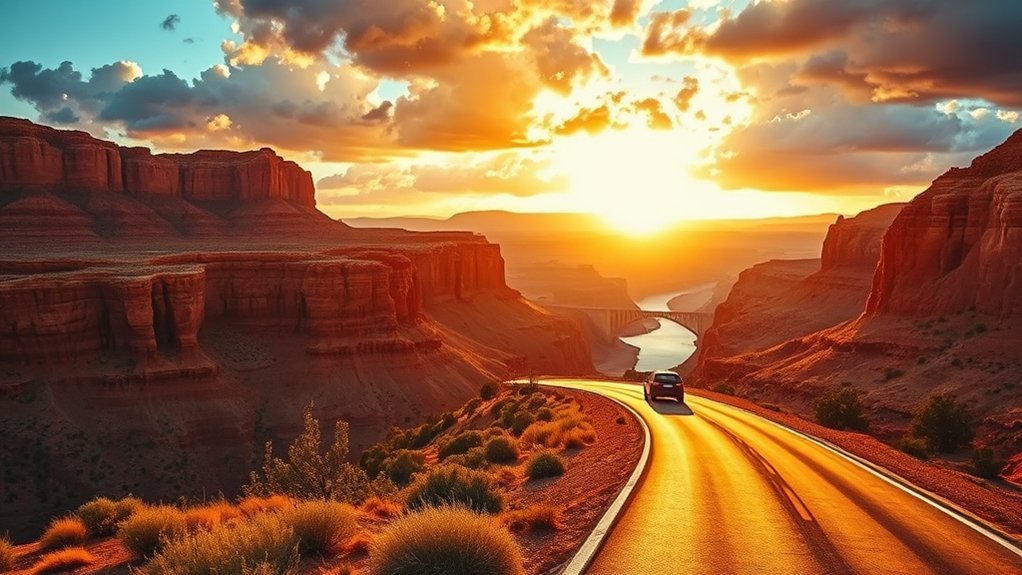
Take the Scenic Byway to Marble Canyon and pull over at the many overlooks and roadside turnouts to stretch your legs and take in sweeping views. Time your drive for sunrise or sunset for dramatic colors that make for great photos. Read the interpretive signs at each stop to learn the geology shaping the cliffs and canyons you’re admiring.
Scenic Overlooks and Pullouts
Along the drive toward Marble Canyon you’ll find a string of scenic pullouts and overlooks that make it easy to stop, stretch, and drink in the Colorado River’s winding gorge and the painted cliffs beyond. You can park safely, step onto compacted viewpoints, and inspect geology up close without straying from the road. Each stop offers clear sightlines, brief trails, and interpretive signs that explain what you’re seeing. Pack water, sun protection, and sturdy shoes for a quick scramble to better angles. Expect wind and sudden light changes; these spots are perfect for a calm pause, not long hikes.
- A narrow ledge framing river bends and rippled sandstone
- Red walls streaked with white limestone veins
- Distant bridge arching over turquoise water
- Juniper clusters clinging to cliff edges
- Hawk silhouettes circling thermal columns
Photographic Sunrise/Sunset Spots
A sunrise or sunset drive on the Scenic Byway to Marble Canyon will reward you with dramatic light that sculpts the cliffs and turns the river into a ribbon of molten color; pull over at the established overlooks and you can set up quickly for golden-hour shots without scrambling over fragile terrain. You’ll find parking, viewpoints, and railings that frame compositions immediately. Bring a tripod, wide and telephoto lenses, and neutral-density or graduated filters to balance sky and shadow. Scout a few stops in daylight so you know where to park after dark. Stay mindful of safety—watch traffic, keep a flashlight for approach and exit, and respect closures. If clouds gather, switch to intimate canyon details and backlit rock textures for moody alternatives.
Roadside Geology Explanations
Wind-swept cliffs and layered buttes act like an open-air textbook as you drive the Scenic Byway to Marble Canyon, and every pullout has a story to tell about ancient seas, shifting deserts, and the Colorado River’s slow carving. You’ll stop at interpretive signs that point out strata, fossil-bearing limestones, and the dark varnish on exposed rock. Read short plaques, compare colors, and imagine time scales while staying on stable ground. Binoculars help you spot hoodoos and perched boulders; a camera freezes textures and shadow. These roadside lessons turn curiosity into context, so you’ll appreciate canyon formation without a guide.
- Red and cream sandstone layers like cake slices
- Ripple marks hinting at prehistoric beaches
- Desert varnish glossing cliff faces
- Rounded river-polished cobbles
- Thin limestone beds with fossil fragments
Visit Lone Rock Beach
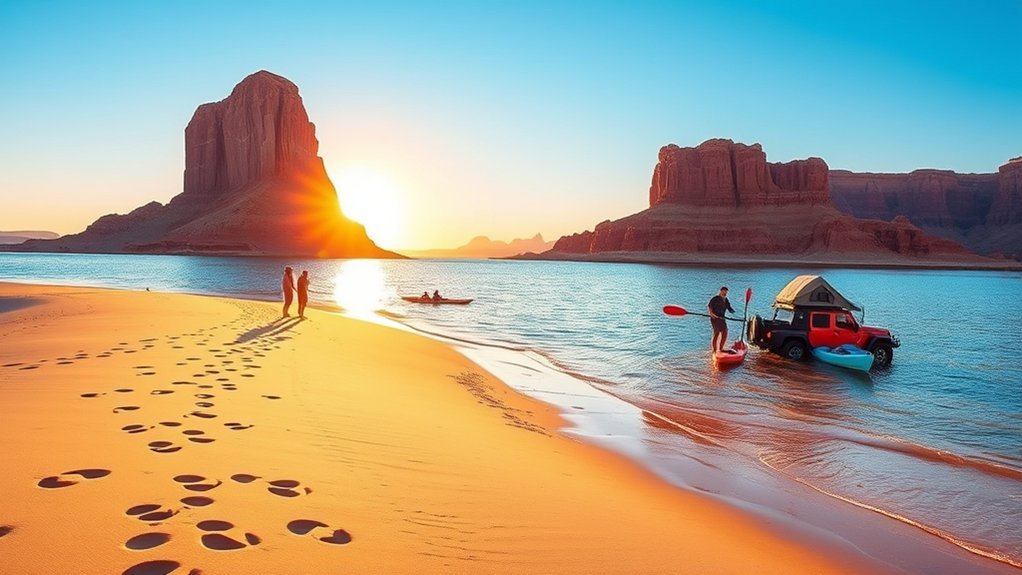
Drive up to Lone Rock Beach and you’ll find one of Lake Powell’s most accessible and striking shorelines, with the solitary sandstone monolith rising from the water like a natural lighthouse. You can park close to the sand, unload gear, and step onto a wide, gravelly beach that gently slopes into warm, clear water ideal for swimming or paddling. The rock is a handy landmark for orientation—use it to judge wind and current when launching a kayak or paddleboard. If you brought a truck or ATV, designated access areas make loading and unloading straightforward; observe posted rules and stay off fragile vegetation. Shade is scarce, so bring sun protection, refillable water, and a small shade canopy if you plan to linger. At sunset the monolith glows, offering a peaceful spot to relax while listening to lapping waves. Pack out trash, respect other visitors, and check local conditions before heading out.
Photography at Upper Antelope Canyon
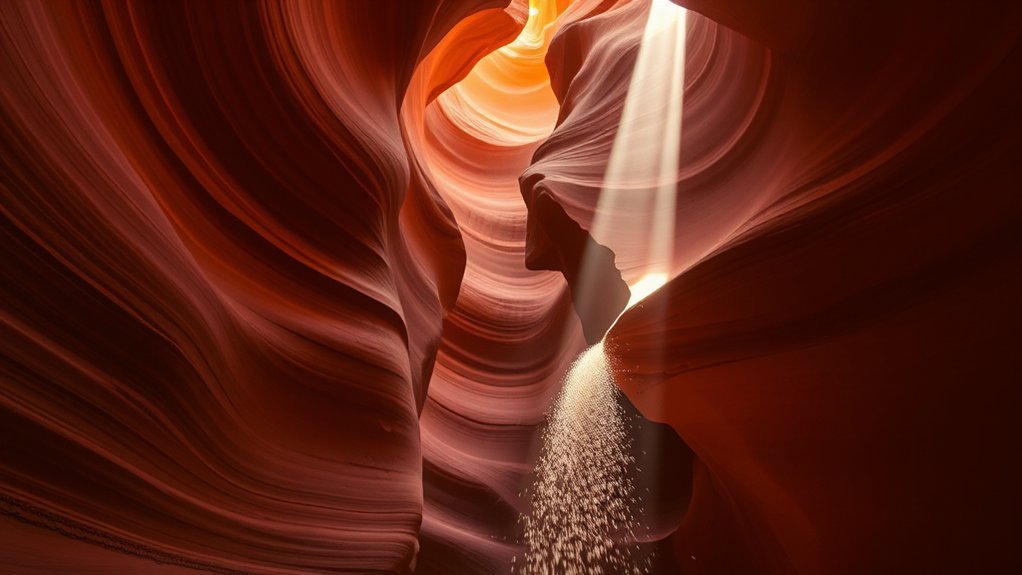
Step into Upper Antelope Canyon and you’ll find light painting the sandstone in ribbons of gold and crimson that practically beg to be photographed. You’ll want a wide-angle lens to capture sweeping curves and a tripod for low-light detail, but expect to handhold during busy tours. Watch how shafts of sunlight pierce the canyon at midday — that’s your moment for dramatic beams. Move slowly, frame negative space, and let the canyon’s textures become your lead subject. Respect guide instructions and other photographers; composition beats gear when access is limited.
Light paints Antelope Canyon’s flowing sandstone; wait for midday beams, favor composition over gear, and move slowly.
- Narrow corridors of rippled rock glowing like molten copper
- Thin shafts of light slicing dust into visible veins
- Smooth, flowing walls that read like frozen waves
- Tiny alcoves where shadow reveals delicate striations
- Silhouetted figures adding scale against vast, curving walls
Plan morning or midday visits for light shafts, shoot RAW, and keep your settings ready — the canyon changes by the minute.
Sunset at Wahweap Overlook
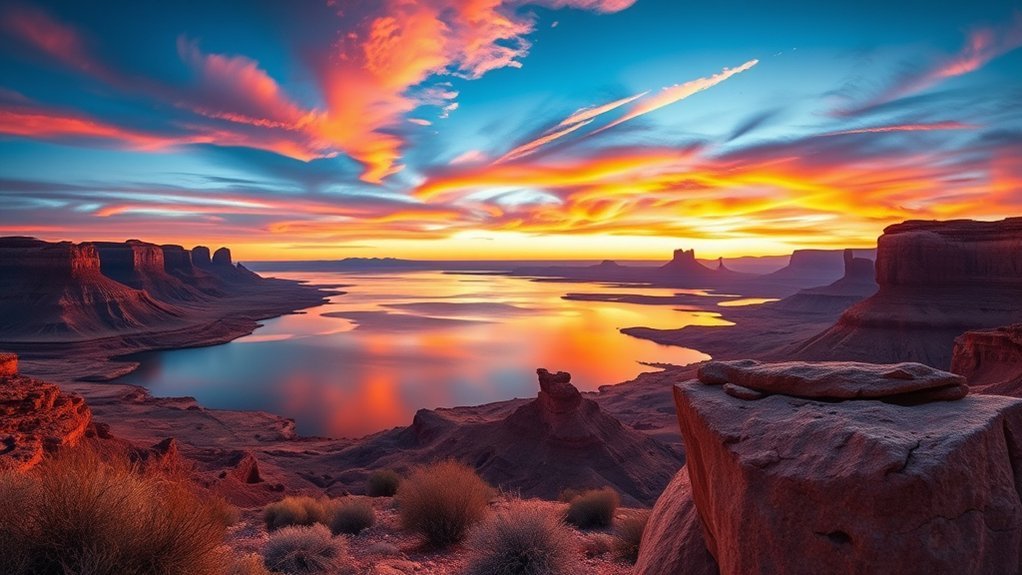
Head to Wahweap Overlook a little before sunset so you can scout the best viewing spots along the rim and choose a composition that frames Lake Powell and the red cliffs. Watch the light shift—golden hour through the first flush of twilight gives you the warmest colors and the longest window for photos. Remember to park in designated areas, keep a safe distance from the edge, and bring a flashlight for the walk back after dark.
Best Viewing Spots
When the sun dips toward the Vermilion Cliffs, Wahweap Overlook becomes the place to be—bring a light jacket, a camera, and a little patience. You’ll find several nearby vantage points that each offer a different slice of Page’s drama: the overlook’s rim for broad panoramas, a short trail for closer rock textures, a bench tucked behind a juniper for quiet reflection, the parking bluff for quick-access shots, and a low canyon lip for dramatic silhouettes. Pick a spot that suits your energy and equipment, set up before golden hour, and settle in. The air cools fast and the views reward anyone who waits—no special gear required, just good boots and steady hands.
- Wide rim view with sweeping cliffs
- Trail-side rocks up close
- Juniper-shaded bench for solitude
- Parking bluff for easy framing
- Canyon lip for stark silhouettes
Timing and Light
As the sun slides toward the Vermilion Cliffs, plan to arrive at least 30–45 minutes before official sunset so you can claim a good spot, set up your camera, and watch the light evolve; the real magic often happens during that brief window of late-afternoon warmth and the 20–30 minutes after sunset when colors deepen and shadows lengthen. You’ll see cliffs and canyon rims shift from ochre to molten gold, then to purples and deep blues as indirect light sculpts texture. Bring a small tripod, a lens cloth, and layered clothing—the temperature drops fast. Shoot bracketed exposures for high dynamic range, switch to a wider lens for sweeping panoramas, then zoom in on glowing strata. Stay patient: timing is everything for dramatic, memorable shots.
Safety and Parking
Although the overlook feels remote, plan your arrival and exit with care: parking is limited, shoulder space is narrow, and evening light draws crowds fast, so pull in early and park fully within marked stalls to avoid blocking others. You’ll want sturdy shoes for uneven ground, a headlamp for post-sunset returns, and a charged phone for navigation. Stay behind railings, keep kids close, and watch footing on loose shale near the rim. If you drive an RV or trailer, scout turnarounds beforehand; tight curves and low clearance spots can trap larger vehicles. Respect private driveways and local signage to avoid fines or towing.
- Golden light spilling over layered sandstone
- Kids silhouetted against a deepening sky
- Headlamp beams on a dusty path
- Tail lights carving the slope
- Wind-tossed scrub at the cliff’s edge
Off-Road Tour of the Surrounding Desert
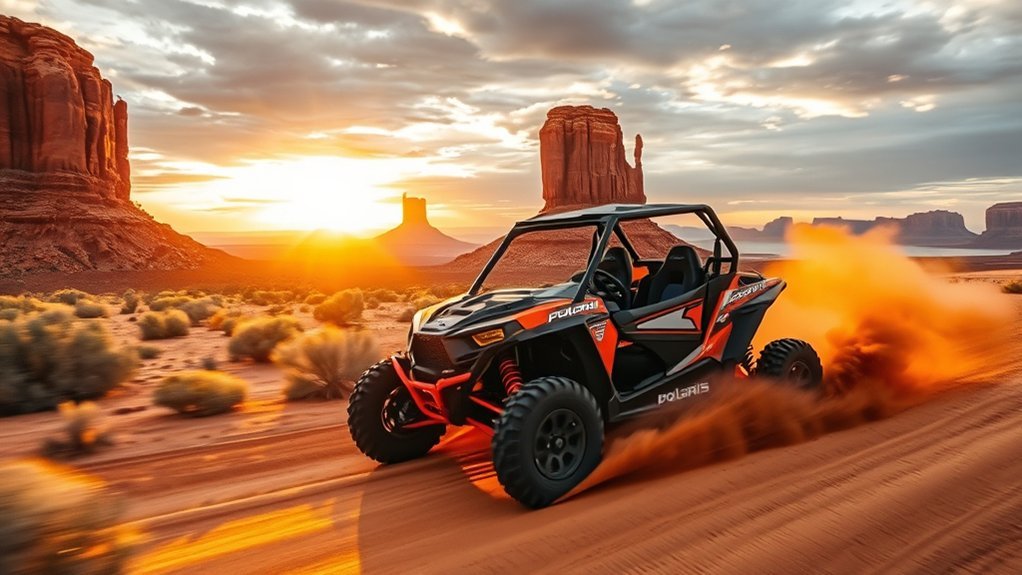
If you want to leave paved roads behind, an off-road tour around Page plunges you into red-rock canyons, slickrock fins, and wide-open desert that feel almost otherworldly. You’ll bump along sandy washes and narrow jeep tracks, watching layers of ochre and rust unfold as guides point out Navajo sandstone formations and hidden arches. Choose a reputable outfitter who provides a sturdy 4×4, water, and a short safety briefing; trails can be rutted, steep, and deceptively remote. Bring closed-toe shoes, sun protection, extra water, and a camera with a secure strap — sudden drops and jostling make loose gear a risk. Expect brief hikes to viewpoints, explanations of geology and local ecology, and chances to explore slot canyons or dinosaur tracks off the main path. Tours vary in length and intensity, so match your comfort level: morning trips beat midday heat, and a half-day option gives a satisfying taste without overdoing it.
Stargazing at Glen Canyon National Recreation Area
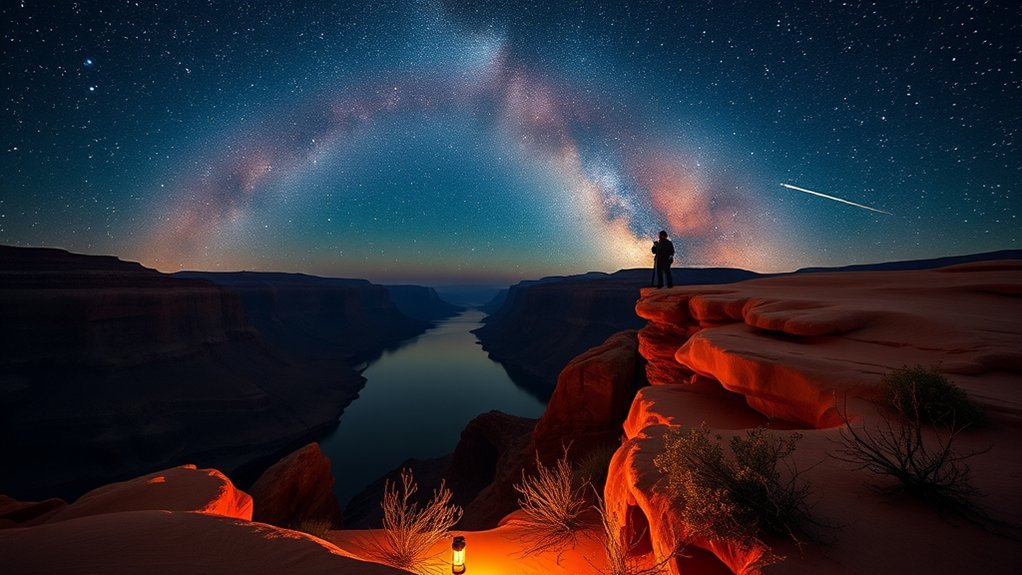
Head to Glen Canyon National Recreation Area for some of the darkest, clearest night skies near Page, with favorite viewing spots around Lone Rock and the quieter lakeshore coves. Aim for late fall through early spring when the air is crisp and Milky Way visibility is best, and check moon phases to pick truly dark nights. Bring layered clothing, a red flashlight, a star chart or app, and always tell someone your plan — cell service can be spotty and terrain is uneven.
Dark-Sky Viewing Spots
Under a vault of ink-black sky, Glen Canyon National Recreation Area becomes one of northern Arizona’s best places to stargaze — clear nights, minimal light pollution, and wide horizons give you an intimate view of the Milky Way, planets, and meteor streaks. You’ll pick a quiet pullout or shoreline, set up a reclining chair or blanket, and let your eyes adjust while binoculars or a small scope reveal craters and star clusters. Bring layered clothing, a red-light headlamp, and a star app for orientation. Expect silence broken only by water and wind; stay safe near cliffs and follow park rules.
- Silhouetted mesas framing the Milky Way
- Rippling lake reflections of stars
- Isolated dirt roads with 360° views
- Quiet picnic benches for gear
- Cool, clear air sharpening constellations
Peak Viewing Months
Because Glen Canyon sits high and dry with consistently clear skies, the best stargazing runs from late spring through early fall — roughly May through October — when warm nights, low humidity, and minimal cloud cover give you the sharpest views of the Milky Way and planetary alignments. You’ll time trips around new moons for darkest skies; summer offers galactic center views, while late spring and early fall give comfortable evenings and good meteor shower opportunities. Nights can still be cool, so plan layers and arrive before dusk to watch the sky deepen. Below is a simple table to capture the mood and choices you’ll face.
| Wonder | Feeling | When |
|---|---|---|
| Milky Way | Awe | Summer |
| Planets | Curiosity | May–Oct |
| Meteors | Excitement | Late summer |
Gear and Safety Tips
When the sky goes dark over Glen Canyon, bring gear that keeps you comfortable, safe, and focused on the stars: a headlamp with a red filter, layered clothing for wide temperature swings, water, and a backpack to carry spare batteries and a star chart or app. You’ll want sturdy shoes for uneven trails, insect repellent, and a warm hat — desert nights bite. Keep to marked areas, tell someone your plan, and watch footing near cliffs. Use red light to preserve night vision, limit noise to respect other viewers, and let your phone stay on low brightness for photography or navigation. Plan for emergency cell dead zones and carry a whistle and basic first-aid kit.
- A red-beamed headlamp painting the trail
- Puffy jacket under starlight
- Cold hands warmed by gloves
- Clear map or constellation app
- Small first-aid kit and whistle
Discover the Navajo Village Heritage Center
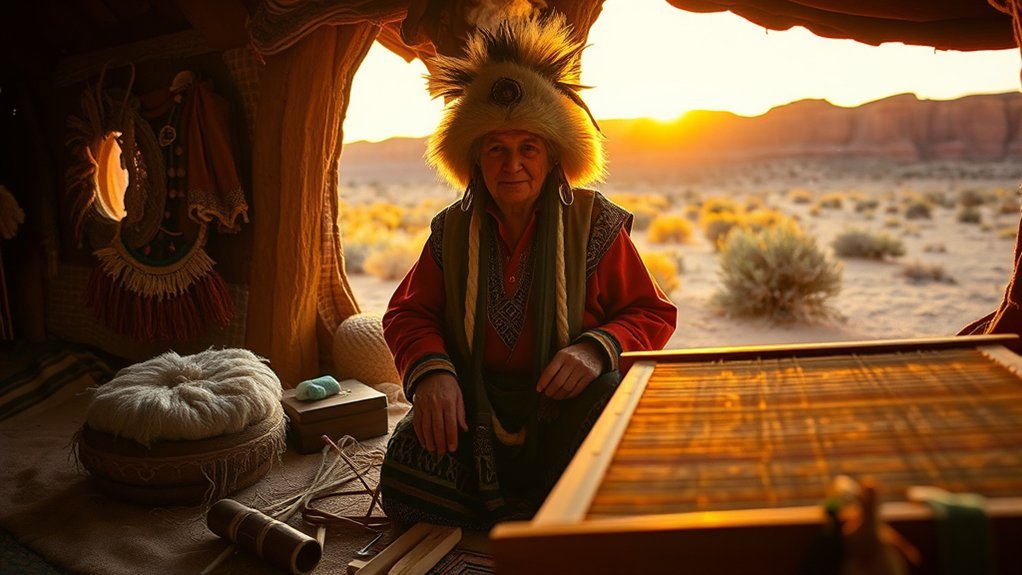
Curious about Navajo life and traditions? Visit the Navajo Village Heritage Center to step into living culture: you’ll see hogans (traditional homes), watch skilled artisans weave rugs and build jewelry, and hear storytellers share creation tales and clan histories. Interactive demonstrations let you try handcrafts or grind corn, giving tactile insight rather than passive observation. Guided tours explain ceremonial meanings, language basics, and seasonal practices—ask questions; guides welcome curiosity and clarify respectful behavior.
Plan for about 60–90 minutes, wear comfortable shoes, and bring water and sun protection—the site is exposed. Check performance times so you don’t miss dances or songs. Photography is often allowed but respect people’s privacy and any no-photo signs. You’ll leave with a deeper appreciation for Navajo resilience and artistry; consider supporting the community by purchasing authentic crafts directly from artisans. It’s an educational, respectful stop that complements outdoor adventures in Page.
Hike the Hanging Gardens Trail
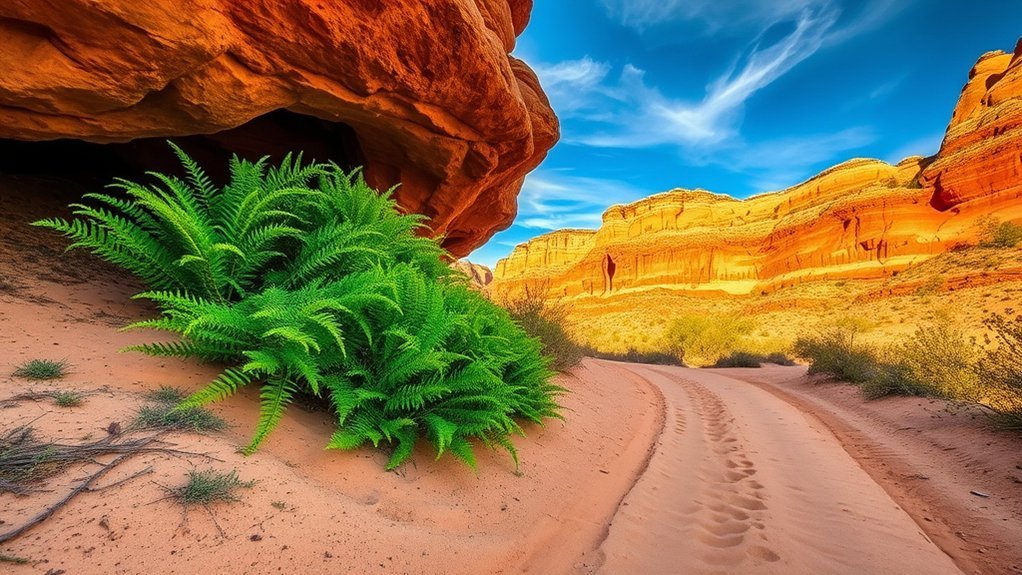
Perched above a quiet bend of Glen Canyon, the Hanging Gardens Trail rewards you with a short but surprisingly lush stroll where desert meets hidden water. You’ll follow a shaded wash lined with ferns and cottonwoods, then climb a few sandstone steps to reach pockets where springs feed mossy ledges. The route is brief—easy for most—but brings an invigorating contrast to Page’s arid landscape.
- Sunlight filtering through tamarisk leaves onto damp rock
- Bright green ferns spilling from narrow cliff seams
- Tiny waterfalls seeping from sandstone, creating slick, glinting streaks
- A quiet overlook that frames the canyon bend and distant water
- Birdsong and the faint scent of wet earth and creosote
Pack sturdy shoes for slick patches, carry water, and use caution on exposed edges. Visit earlier in the day for cooler temperatures and softer light. The trail’s intimacy makes it perfect for a reflective pause between Page’s larger attractions.
Take a Jet Boat Tour on the Colorado River
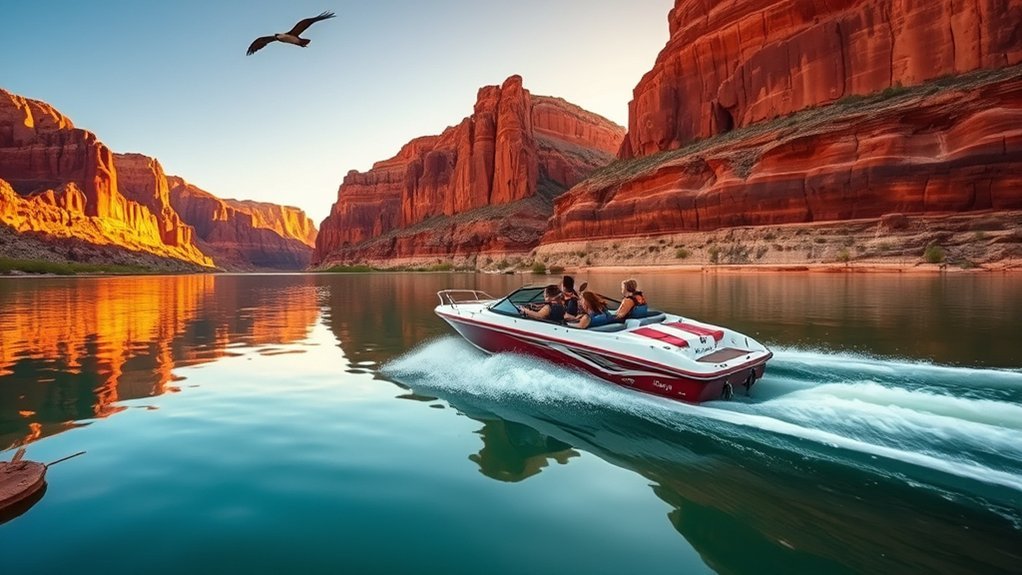
Hop on a jet boat and feel the thrill as you blast through rapids while gripping the rails. You’ll glide past towering canyon walls, snapping photos of sculpted sandstone and narrow side canyons. Keep your eyes peeled for eagles, bighorn sheep, and fascinating rock layers that tell the Colorado River’s story.
Thrilling Rapids Experience
Brace yourself for a rush as a jet boat slices through the Colorado River, sending spray into the air and offering up-close views of canyon walls you can’t reach by foot; the ride combines heart-pounding rapids with smooth stretches where you’ll spot nesting raptors and glinting geological layers. You’ll grip the rail during sudden, thrilling turns, feel the engine vibrate, and laugh as cool mist hits your face. Wear a windbreaker, secure your camera, and listen to the guide’s safety briefing—they’ll point out eddies, safe viewing spots, and ideal photo windows. After each rapid you’ll catch your breath and scan the water for hidden alcoves and wildlife.
- Spray stinging your cheeks
- Boat hugging narrow channels
- Whitewater bursting around the bow
- Guides shouting excited cues
- Raptors circling overhead
Scenic Canyon Views
As the jet boat slips into quieter stretches of the Colorado, you’ll trade the adrenaline of rapids for sweeping canyon panoramas—towering sandstone walls banded with color, sunlit ledges, and narrow side alcoves that only the boat can reach. You’ll feel the canyon’s scale as the captain eases close for photos, pointing out hidden alcoves and ledges sculpted by millennia. Bring a light jacket — shade and wind can be brisk — and a camera with a polarizer to tame glare. Tours vary in length; choose one that balances time on the water with shoreline stops. Below is a quick comparison to help decide.
| Duration | Focus | Best For |
|---|---|---|
| 1–2 hr | Views | Quick highlights |
| 3–4 hr | Stops | Photography |
| 5+ hr | Combo | Exploration and walks |
Wildlife and Geology
After you’ve soaked in the canyon views, turn your attention to the life that makes the river corridor vibrate — both the creatures that call it home and the rock story written in every stratum. Take a jet boat tour on the Colorado River to get close to nesting raptors, basking lizards, and ancient sandstone layers carved by millennia of water. You’ll feel the spray, hear guides point out fossils and cross-bedded sandstone, and learn how uplift and erosion shaped the landscape. Tours are fast, accessible, and offer photo stops at cliff alcoves. Bring sun protection, a light jacket for wind, and binoculars. Expect knowledgeable narration, sudden canyon turns, and quiet moments where geology and wildlife coexist in plain view.
- Raptors circling thermals above sheer walls
- Petroglyph-like layers exposed in banded rock
- River otters slipping between boulders
- Cacti clinging to narrow ledges
- Fossil fragments embedded in sandstone
Explore the Paria Canyon–Vermilion Cliffs Wilderness
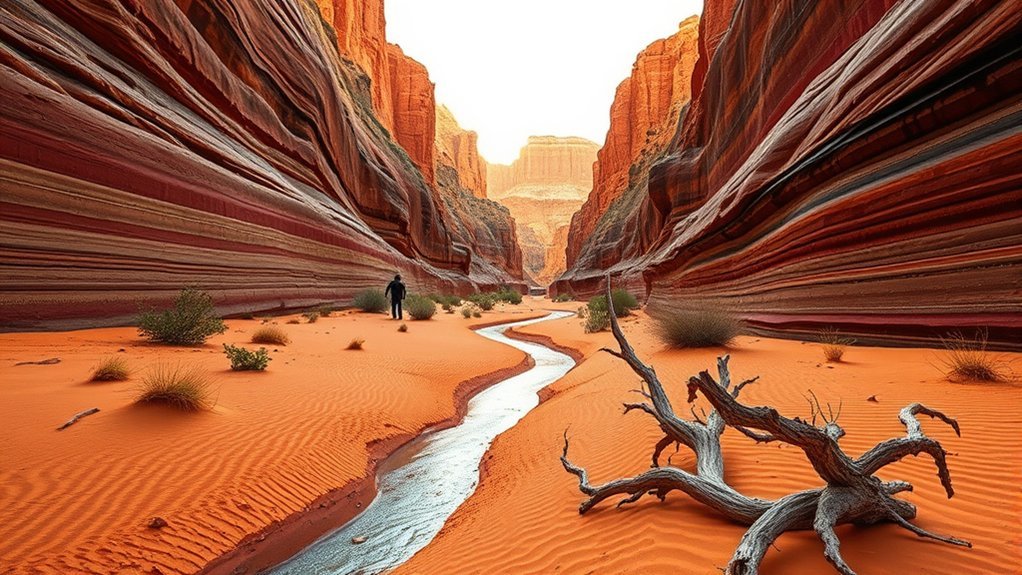
If you’re craving narrow slot canyons, sweeping red-rock vistas, and a true backcountry experience, the Paria Canyon–Vermilion Cliffs Wilderness delivers in spades. You’ll follow the Paria River through dramatic narrows, hoodoos, and towering cliffs that shift color with the sun. Plan ahead: permits are required for overnight trips and popular hiking corridors fill fast. Pack plenty of water, a topographic map, and a reliable navigation tool—cell reception is spotty. Day hikes from the Paria Contact Station let you sample highlights without committing to a multi-day trek, while longer journeys offer dispersed camping and quiet stargazing. Watch for seasonal flash floods; avoid narrow sections during storm forecasts. Respect fragile cryptobiotic soil and cultural sites by staying on durable surfaces and practicing Leave No Trace. If you want solitude and epic geology, this wilderness rewards careful planning with immersive landscapes you won’t forget.
Visit the Page Public Library and Local Art Exhibits

Often tucked between the tourist stops, the Page Public Library offers a quiet, welcoming break where you can browse local history displays, check out regional guidebooks, or catch a rotating exhibit from area artists. You’ll find friendly staff who’ll point you to maps, recommend lesser-known trails, or tell you about upcoming gallery nights. The small gallery walls display watercolor washes of canyon light, bold landscape photography, and woven textiles inspired by Navajo patterns. It’s a great spot to cool off, plan the next leg of your day, or pick up a postcard painted by a local. Don’t miss the community bulletin board for pop-up events and artist talks. Bring a sketchbook or camera — the atmospherics and quiet corners invite lingering.
- Sunlight slanting through high windows onto wooden reading tables
- Framed photos of Horseshoe Bend and local landmarks
- Hand-lettered event flyers for gallery openings
- A shelf of regional geology and Native American history
- Cozy nooks perfect for planning your afternoon
Scenic Flight Over the Grand Canyon and Lake Powell
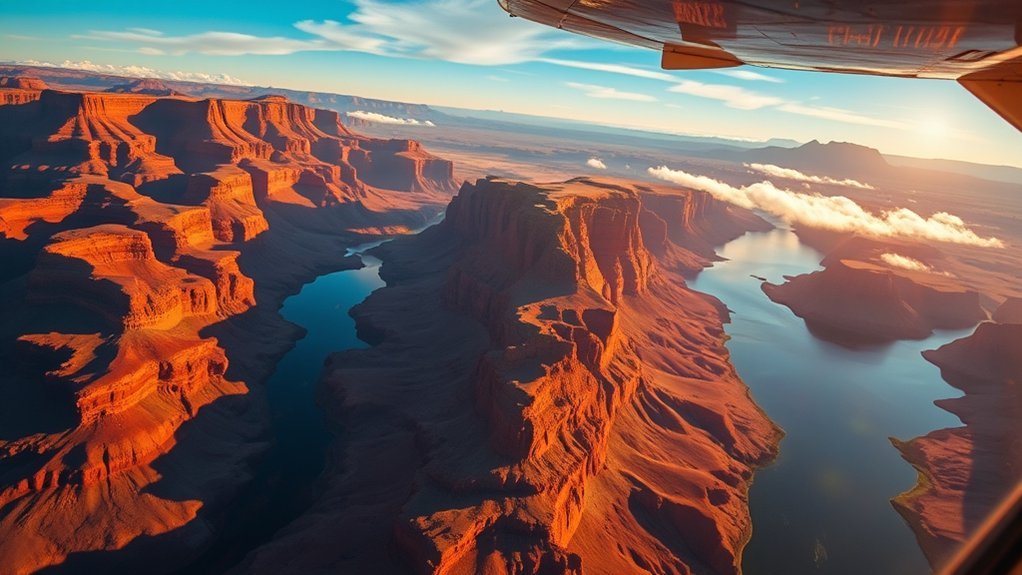
You can’t beat a scenic flight for jaw-dropping aerial Grand Canyon views that show the scale and colors you just can’t get from the rim. Choose from short canyon hops or longer Lake Powell overflight options that include shoreline viewpoints and Rainbow Bridge flybys. Bring a camera, book a morning slot for calmer air, and ask about window seats and narration.
Aerial Grand Canyon Views
When the plane lifts you over the red cliffs and mirror-still waters, the scale of the Grand Canyon and Lake Powell hits in a single, unforgettable sweep. You’ll spot layered rock bands, tiny river ribbons and islands that look carved from rust. Keep your camera ready, but also take moments to just watch—colors shift with every degree of sun. Expect gentle turbulence, clear narration from the pilot, and windows that frame impossible perspectives. Plan for sunglasses, a light jacket, and a phone battery saver. Choose a seat on the canyon-facing side if you can.
- Aerial striations revealing millions of years of geology
- Narrow river canyons threading sunlight below
- Rippling water reflecting canyon rims
- Tiny boats dwarfed against vast sandstone
- Sudden, vast shadows crossing the cliffs
Lake Powell Overflight Options
Float above rust-colored mesas and glassy water as pilots guide you on Lake Powell overflight options that vary by length, aircraft, and sights included. You’ll choose from short scenic loops to extended Grand Canyon-Lake Powell combos; helicopters offer nimble, low-level thrills while fixed-wing planes give smoother, expansive panoramas. Check flight duration, seating, and window type—some tours include landing at viewpoints or photo stops. Morning flights often have calmer air and softer light; afternoon trips can highlight dramatic shadows on canyon walls. Listen for pilot narration, bring sunscreen and a camera with a strap, and confirm weight limits and cancellation policies. Book early during peak season and ask about custom routes if you want specific coves, Rainbow Bridge views, or Navajo-led insights.
Mountain Biking on Local Desert Trails
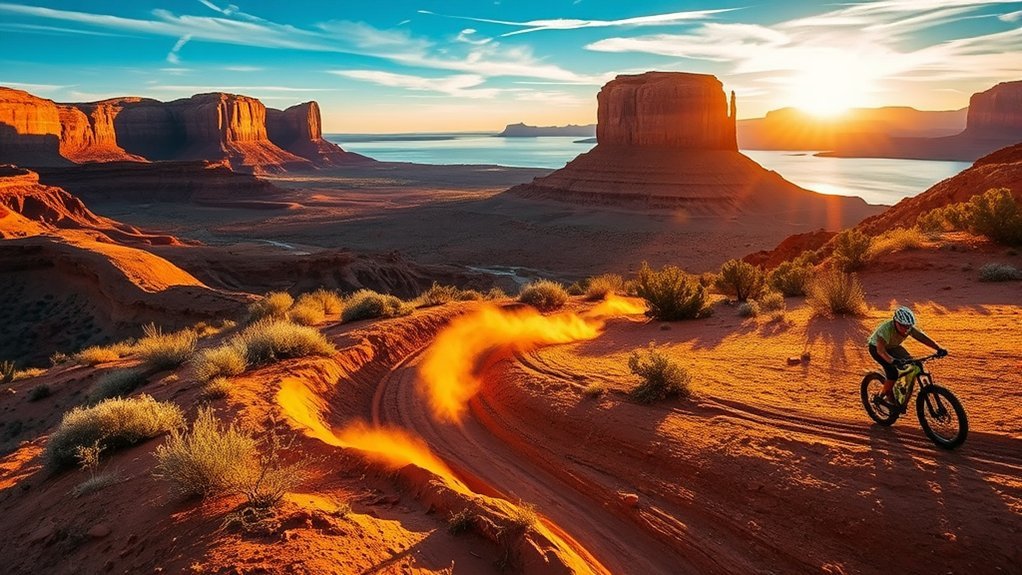
Framing the red-rock landscape with a ribbon of singletrack, Page’s desert trails invite riders of all skill levels to push speed and technique while soaking in wide, sunlit views. You’ll find hard-packed dirt, slickrock slabs, and playful wash crossings that reward cautious line choice and confident momentum. Start early to beat heat, carry extra water, and check tire pressure for sharp, gritty surfaces. Look for loops that mix flowy descents with short, technical climbs; they give you options to ride relaxed or drill skills. Local trailheads are usually unmarked, so bring a map or GPS and tell someone your route. Respect wildlife, leave no trace, and yield politely to hikers. After a solid ride, you’ll appreciate how the landscape feels earned.
Page’s red‑rock singletrack tempts riders with sunlit vistas, slickrock, wash crossings, and loops that reward careful lines and confident momentum
- Narrow singletrack winding between sandstone fins
- Sun-baked mesas shimmering in midday light
- Patches of saguaro and low scrub for shade breaks
- Rock gardens that test balance and braking control
- Wide viewpoints perfect for short rest stops
Visit Horseshoe Bend During Golden Hour
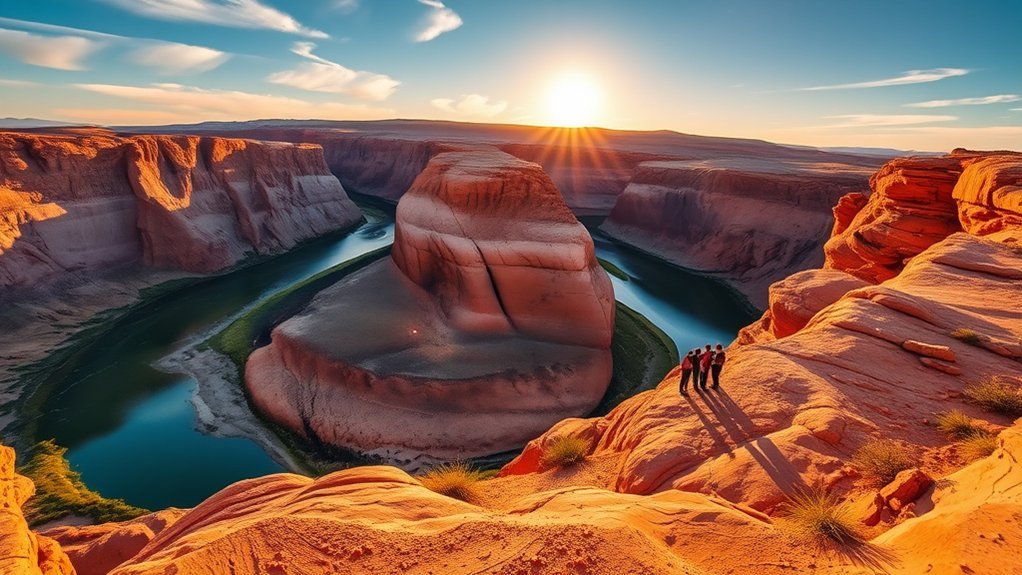
After a morning on the trails, head to Horseshoe Bend for golden hour to watch the Colorado River glow as low sunlight carves the canyon in warm tones. You’ll arrive as shadows lengthen and the sandstone shifts from pale orange to deep copper, making photo highlights pop and textures stand out. Walk the short rim trail—it’s under a mile round trip—but give yourself time to find a safe vantage point, set up a tripod, or brace your phone against the rocks. Bring water, a windproof jacket, and closed-toe shoes; the overlook gets gusty and the path is sandy. Expect crowds; arrive 30–45 minutes before sunset to claim space and watch the light change. Respect ropes and signs—edges are crumbly and dangerous. As colors deepen, practice slow exposures for silky river reflections or bracket shots to capture extreme contrast. When the sun slips away, linger a bit for the blue-hour mood before heading back to town.
Enjoy a Picnic at Lone Rock Campground
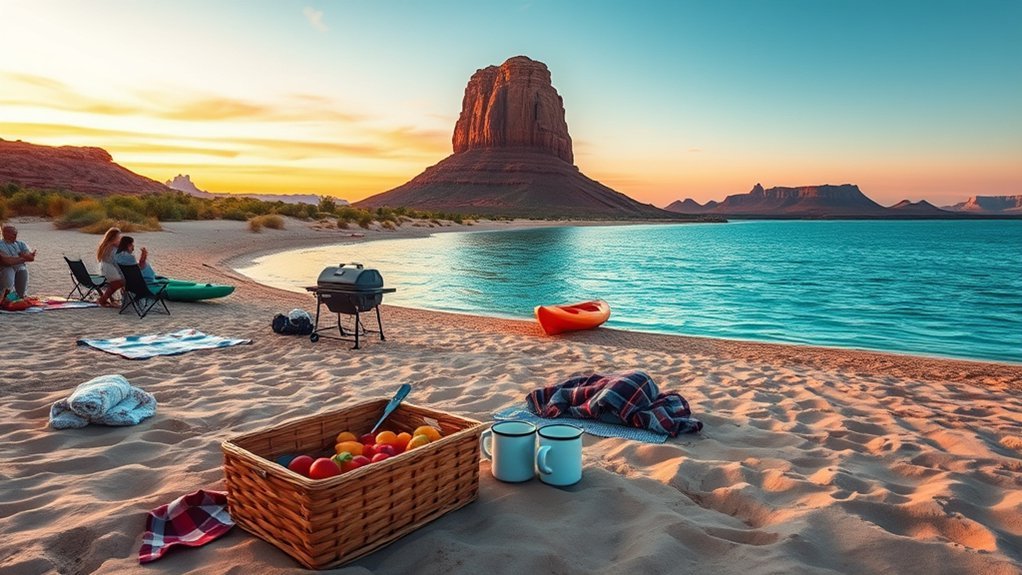
Pack a cooler and spread out a blanket beneath the wide desert sky at Lone Rock Campground, where picnic spots sit right on the shoreline of Lake Powell and the sandstone butte rises like a quiet guardian. You’ll find easy parking, sandy seating, and the option to tailgate beside your vehicle, so unpacking is simple and stress-free. Shade is limited, so bring a pop-up canopy, sun hats, and plenty of water. Time your lunch for softer light and calmer winds, and keep a camera ready for reflections on the water.
Spread a blanket at Lone Rock—sandstone warms your hands, turquoise waves lap, bring shade, water, and a camera.
- Warm, orange sandstone warming your hands as you set dishes down
- Turquoise lake lapping near your feet, tiny waves sparkling
- Distant boat hums and the occasional call of a gull
- Cool breeze carrying a faint scent of algae and desert creosote
- Smooth picnic rocks doubling as seats or side tables
Pack out trash, follow campground rules, and leave the shoreline as you found it.
Explore the Lees Ferry Area
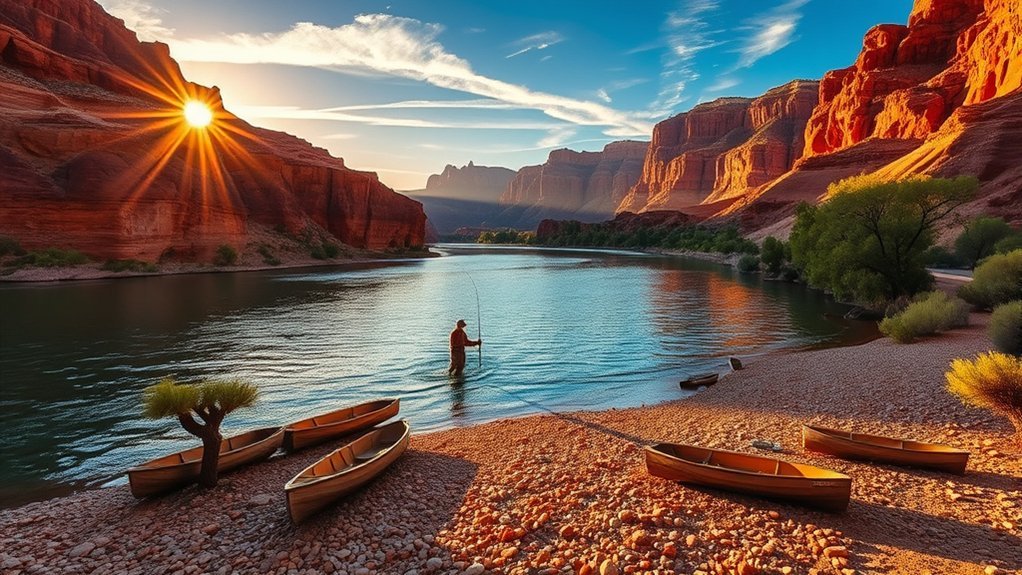
If you follow the narrow road down into Marble Canyon, you’ll find Lees Ferry—a quiet stretch where the Colorado River slows and history, fishing, and river access converge. You can park at the small lot, stretch your legs on the shaded trail to the riverbank, and scan native cottonwoods and red-rock cliffs that frame the water. Bring sturdy shoes; the terrain’s uneven near the old ferry site and the short interpretive trail that explains John D. Lee’s crossing. Anglers will want a valid Arizona license and gear for trout and bass—cast from shore or join a guided drift for better access. If you’re launching a private raft, check current permits and river conditions at the ranger station; readied boats and life jackets keep outings safe. At sunset, the cliffs glow; you’ll find quiet spots to photograph reflections and listen to flowing water, a peaceful contrast to Page’s busier attractions.
Take a Pottery or Craft Workshop With Local Artists
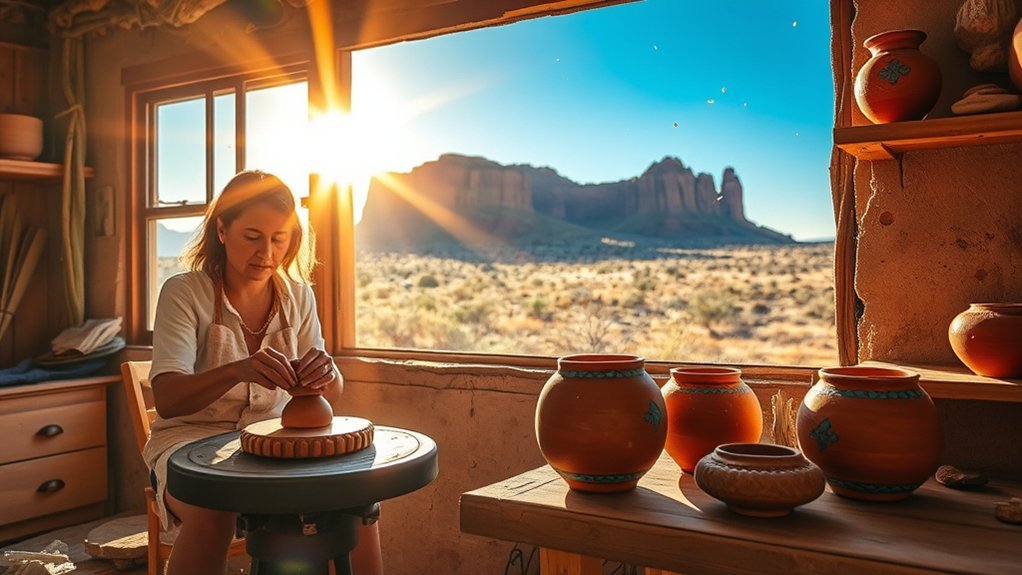
Shaping clay with local potters is a hands-on way to slow down and take home something personal from Page—many studios welcome beginners and guide you through wedging, throwing, and simple glazing so you leave with a finished piece or a kiln-fired coupon to collect later. You’ll roll up your sleeves, center a lump of clay on the wheel, and feel it respond as the instructor coaches your hands. Workshops run a couple hours, fit into travel days, and often include demonstrations of handbuilding, stamping, and surface techniques so you can try different approaches.
You’ll also find small craft sessions—jewelry, woven bracelets, or desert-inspired painting—that use local materials and motifs. These classes connect you with artists who share stories about the landscape and techniques passed down or innovated here.
- Damp clay spinning under your palms, slick and cool
- Fingers shaping a mug lip, smoothing the thumb rest
- Stamps leaving Navajo-inspired patterns
- A rack of bisque wares waiting for glaze
- Sunlight on a finished painted tile
Birdwatching Around the Marshes and Shorelines
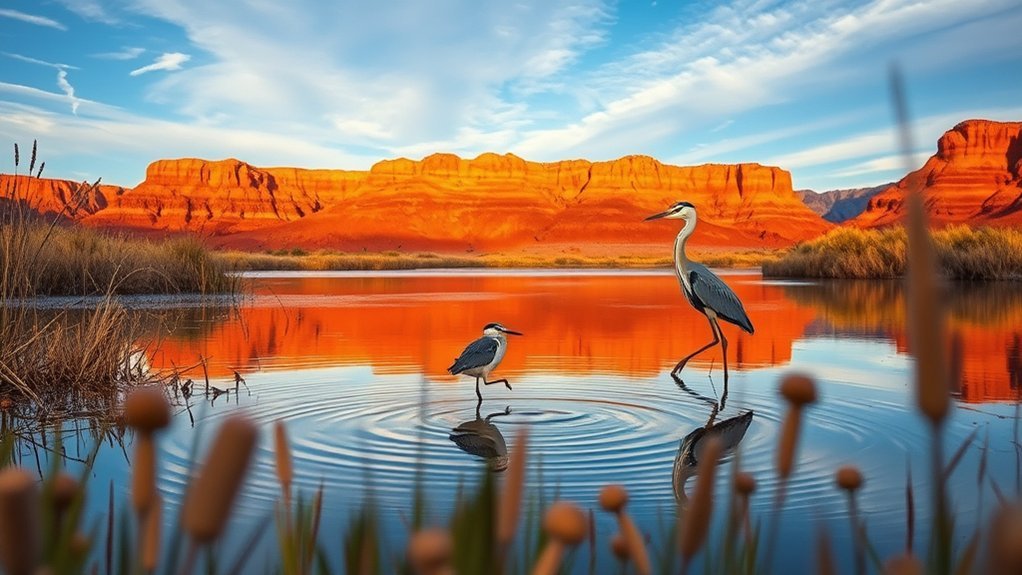
Wandering the marshes and shorelines around Page puts you close to surprising flocks and solitary hunters alike, and you’ll find the quiet salt-and-freshwater edges are especially good for spotting waterfowl, waders, and migratory songbirds. Bring binoculars and a field guide or app; early morning and late afternoon are prime for activity when light flatters plumage and birds feed along mudflats, reed beds, and rocky shallows. Walk slowly on marked trails, scan with a steady tripod or monopod, and listen—calls often betray species before you see them. Look for herons and egrets stalking shallow water, grebes diving offshore, and shorebirds probing exposed sediment. Invasive plants and fluctuating water levels can shift where birds concentrate, so ask local rangers for recent sightings. Respect nesting areas, keep dogs leashed, and use quiet voices to avoid flushing flocks. If you want a targeted outing, join a guided walk or bring a checklist to track seasonal arrivals and build a lasting birding record.
Shop for Navajo and Hopi Jewelry at Local Galleries
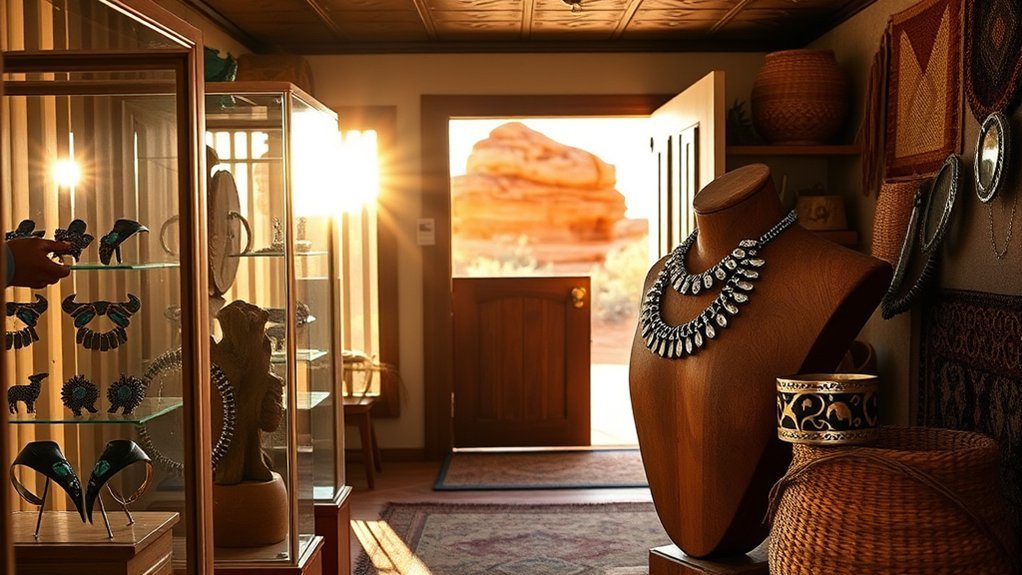
After a morning of scanning marshes and shorelines, head into town to browse galleries that showcase Navajo and Hopi jewelry crafted with generations of skill. You’ll find silverwork, turquoise pieces, and carved shell that tell stories through design. Ask about techniques—overlay, inlay, sandcasting—and the meanings behind symbols; dealers and artists are usually glad to explain provenance and proper care. Try pieces on to check weight and fit, and don’t rush: quality shows in stone matrix, soldering, and patina. If you want a custom item, many artists accept commissions and can incorporate personal motifs or local stones. Bring cash for smaller vendors, but most galleries take cards. Take photos (with permission) and note makers’ names for future purchases. Leave with a piece that’s wearable art and a memory of the region’s living craft.
- a turquoise squash blossom gleaming in sunlit glass
- a hand-stamped silver cuff warmed by your wrist
- tiny spirals symbolizing water and life
- a carved shell pendant with subtle color bands
- a quiet artist polishing a finished necklace
Frequently Asked Questions
Are Drones Allowed at Horseshoe Bend and Surrounding Areas?
No, you can’t fly drones at Horseshoe Bend or much of Glen Canyon National Recreation Area; regulations and closures restrict unmanned aircraft. You’ll need permits for any exceptions, so check park rules and contact rangers before planning flights.
Do I Need a National Park Pass for Antelope Canyon Tours?
No, you don’t need a national park pass for most Antelope Canyon tours; the slot canyon is on Navajo Nation land, so you’ll pay a guided-tour fee and possibly tribal permit charges arranged by the tour operator.
Where Can I Charge an Electric Vehicle in Page?
You can charge your EV at several spots: utility-company public chargers downtown, the fast charger by the visitor center, hotel Level 2 stations, and the grocery-store charger — you’ll never be stranded, chargers await like tiny power oases.
Are Service Animals Allowed on Guided Boat and Canyon Tours?
Yes — you can bring service animals on most guided boat and canyon tours, but you’ll need to notify the operator in advance, follow crew instructions for safety, and keep your animal under control throughout the tour.
What Are the Nearest Medical Facilities for Emergencies in Page?
Like a lifeline on a map, you’ll find Page Hospital (24/7 emergency) downtown, Flagstaff Medical Center about 135 miles away, and several urgent care clinics nearby; call 911 for immediate ambulance transport in serious emergencies.
Conclusion
You’ll want to chase sunrise at Horseshoe Bend, drift through Antelope’s glowing slots, paddle Lake Powell’s quiet arms, and hike to Rainbow Bridge — but remember: Navajo guides, permit rules, and seasonal river levels shape what’s possible. Check tour availability, book permits, and respect sacred sites so your plans match reality. Pack layers, sun protection, and a good camera; with preparation, Page’s geology, wildlife, and culture will reward you fully.

